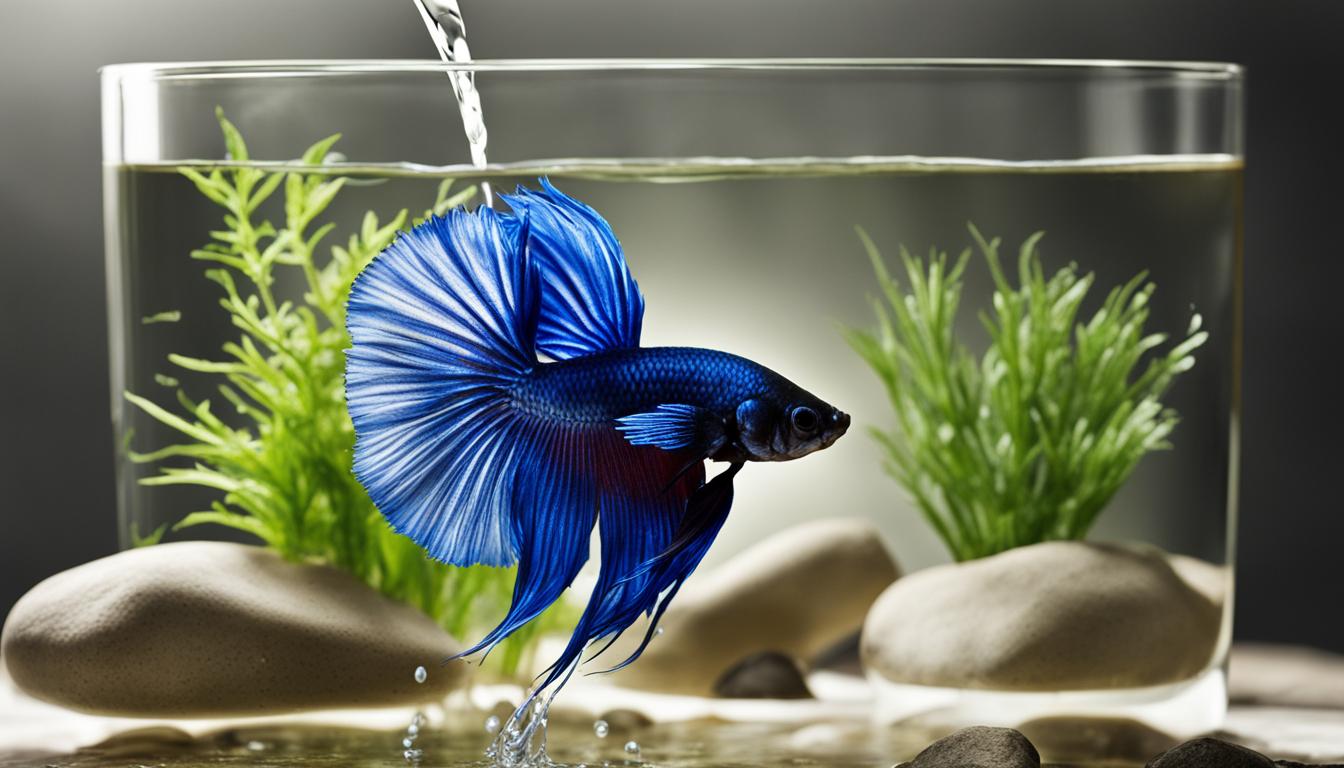Last Updated on 2 years by admin
If you’re a proud betta fish owner, you know how important it is to provide a safe and comfortable environment for your pets. One crucial aspect of betta fish care is ensuring the quality of the water they live in. Tap water, even after going through treatment facilities, can contain harmful contaminants and chemicals that can harm your bettas, making it necessary to treat the water before adding it to their habitat.
While traditional water conditioners can effectively remove these harmful substances, they can also be expensive and may contain other chemicals that can be harmful to your fish. Fortunately, there are natural alternatives to traditional water conditioners that can help you treat tap water for your betta fish safely and effectively, without the use of a conditioner.
In this article, we will explore the importance of treating tap water for betta fish and provide you with step-by-step instructions on how to do it without using a conditioner. We will also cover the importance of testing the treated water and maintaining water quality in the betta fish habitat, and discuss common mistakes to avoid when treating tap water.
Key Takeaways:
- Treating tap water is crucial for providing a safe and comfortable environment for your betta fish
- Natural alternatives can be used instead of traditional water conditioners
- Testing the treated water and maintaining water quality is essential
- Common mistakes such as using the wrong water treatment methods should be avoided
- Alternative solutions like filtered or bottled water can also be used.
Why is Tap Water Treatment Important for Betta Fish?
Betta fish are a popular choice for pet enthusiasts due to their vibrant colors and ease of care. However, it is crucial to provide them with a safe and healthy environment to ensure their well-being. One of the essential aspects of betta fish care is maintaining water quality.
Tap water may contain harmful chemicals such as chlorine and chloramines, which can adversely affect betta fish health. Chlorine and chloramines are added to tap water to kill bacteria and make it safe for human consumption. However, these chemicals can be harmful to fish, causing gill damage and even death in severe cases.
This is why tap water treatment is crucial for betta fish. It removes harmful substances from the water and recreates a natural and safe environment for the fish to thrive in. Regular tap water dechlorination for betta fish can significantly improve their overall health and reduce stress levels.

When betta fish are stressed, they may lose their colors and become more susceptible to diseases and other health issues. Proper tap water treatment and dechlorination can prevent these issues and ensure that your betta fish live happily and healthily.
It is also essential to note that betta fish are sensitive to changes in the environment. Therefore, it is crucial to use a consistent tap water treatment routine to avoid sudden changes in water quality, which can cause stress and harm to the fish.
Why Dechlorinate Tap Water?
Dechlorination is the process of removing chlorine and chloramines from tap water, making it safe for betta fish. Chlorine is a strong oxidizing agent that can damage a betta fish’s gills, skin, and mucous membranes. Chloramines, on the other hand, are a combination of chlorine and ammonia, which can cause severe health issues and even death if not removed from the water.
The dechlorination process can be easily achieved by adding a water conditioner to the tap water. The water conditioner removes the harmful chemicals, making the water safe for betta fish. It is essential to use a water conditioner specifically designed for bettas to avoid any adverse reactions or harm to the fish.
It is also recommended to let the treated water sit for at least 24 hours before adding it to the fish tank. This allows any remaining chlorine and chloramines to dissipate, ensuring that the water is entirely safe for the fish.
Natural Methods to Treat Tap Water for Betta Fish
As a responsible betta fish owner, it’s important to ensure that their habitat is clean and safe. One way to do this is by treating tap water before adding it to their tank without using conditioner. Using natural alternatives for water treatment is not only cost-effective but also reduces the risk of chemical imbalances in the fish’s environment. Here are some natural methods to consider:
Using Aloe Vera
Aloe vera is a natural water conditioner that can be used to treat tap water for betta fish. It contains polysaccharides that remove impurities and toxins from the water, making it a safe and comfortable environment for your betta fish.
To use aloe vera, start by preparing the plant. Cut off a small section of the leaf and remove the outer layer to expose the gel. Use a tablespoon of aloe vera gel for every gallon of water and mix it thoroughly. Allow the water to sit for at least 24 hours before adding it to your betta fish’s habitat.
Using Indian Almond Leaves
Indian almond leaves have natural antibacterial properties that make them a great natural alternative to water conditioner. They also contain tannins that help reduce stress and promote healing in betta fish.
To use Indian almond leaves, start by selecting a few leaves that are clean and healthy. Soak the leaves in a bowl of tap water for a few hours until they sink to the bottom. Once they have sunk, remove the leaves and add the water to your betta fish’s tank. The natural chemicals in the leaves will help to condition the water and create a natural environment for your betta fish.
Using Peat Moss
Peat moss is another natural alternative to water conditioner that can be used to treat tap water for betta fish. It contains humic acids that lower the pH levels in water, making it more acidic and closer to the betta fish’s natural habitat.
To use peat moss, add a small amount to a mesh bag or cheesecloth and place it in a container of tap water. Leave it to soak for at least 24 hours, stirring occasionally. Once the water has turned a light brown color, remove the peat moss and add the water to your betta fish’s tank.
Using natural methods to treat tap water for betta fish is a safe and effective way to ensure the well-being of your pets. These methods can also be used in combination to create an optimal environment for your betta fish.
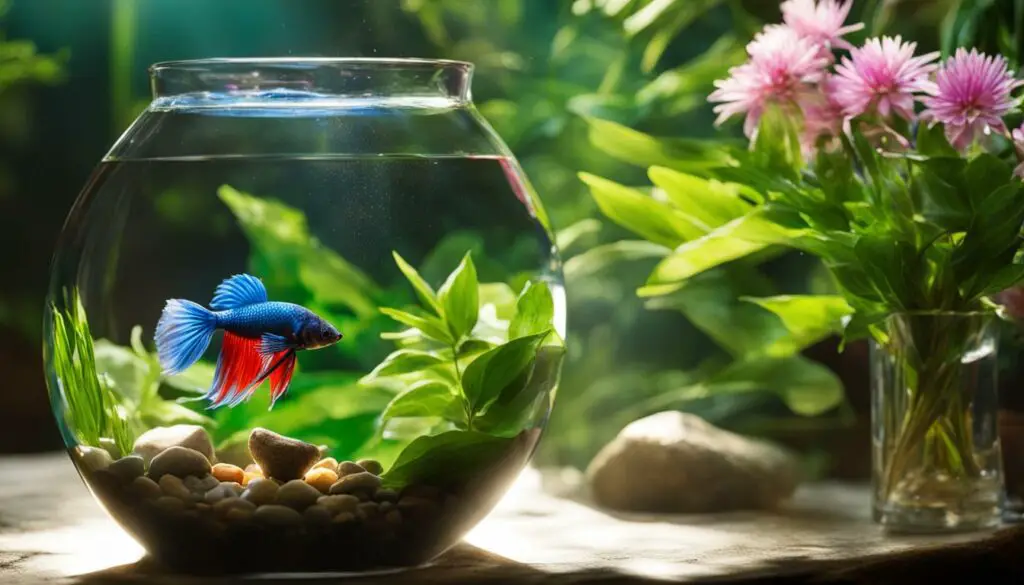
Step-by-Step Guide to Treating Tap Water for Betta Fish Without Conditioner
Treating tap water for betta fish without using conditioner is possible by following these simple steps:
- Allow the tap water to sit: Fill up a container with tap water and allow it to sit for at least 24 hours. This will allow the chlorine in the water to evaporate naturally. You can cover the container to prevent dust and debris from entering. A good rule of thumb is to use the same container where you will house your betta fish to avoid any shock that may occur when changing to a new container.
- Test the water: Using a water testing kit, test the water to ensure that the pH level is between 6.5 and 7.5, and the water hardness is between 3 and 5 dGH (degree of general hardness).
- Boil some peat moss: Bring a pot of water to a boil, add peat moss to the water and boil it for 10-15 minutes. Allow it to cool and then add the peat moss-infused water to the container. This will help to lower the pH and soften the water naturally. Remember that this must be a small amount of peat moss, to avoid changing too much the PH level or the dGH level, which would cause just another problem to deal with.
- Add aquarium salt: Add a small amount of aquarium salt to the container. This will help to promote healing and overall health for your betta fish. A quarter of a teaspoon for five gallons should be sufficient. However, be careful not to overdo the amount, as excessive salt could harm your fish.
- Let the water settle: Allow the water to settle for 24 hours, making sure the temperature is between 76°F and 82°F to ensure it stabilizes to your desired parameters.
- Acclimate the fish: Acclimate the betta fish to the water by slowly adding a small amount of tank water to the container every 15 minutes. Repeat this process until the water levels are equal in the container and the tank. This will prevent shock that may be caused by sudden changes in water parameters.
If you have successfully followed these steps, you can now add the treated water to your betta fish’s habitat. Monitor the water quality regularly to ensure the health and comfort of your betta fish.
Common Mistakes to Avoid when Conditioning Tap Water for Betta Fish
Here are some common mistakes to avoid when conditioning tap water for betta fish:
- Not testing the water before adding it to the tank.
- Using too much salt, which can lead to health problems for the betta fish.
- Not allowing the water to settle or reach the right temperature before adding the fish.
- Overcrowding the tank, which can lead to poor water quality and negative health effects for your betta fish.
By avoiding these mistakes and following the step-by-step guide outlined in this section, you can provide the best possible care for your betta fish without using traditional water conditioners.
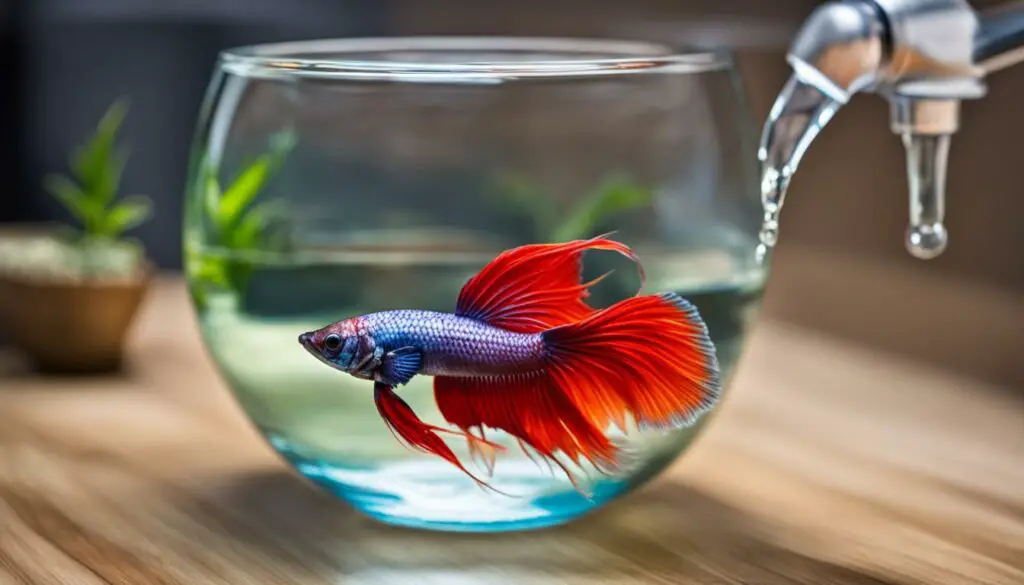
Testing the Treated Water for Betta Fish
Once you have treated the tap water for your betta fish, it is crucial to test the water to ensure that it meets the necessary parameters for their health and well-being.
There are different testing kits available, including pH, ammonia, and nitrate test kits. It is essential to regularly test the water to detect any changes that may occur over time. This is particularly important in a new aquarium or during a water change.
You can use a pH test kit to measure the acidity or alkalinity of the water. The ideal pH level for betta fish is between 6.5 and 7.5. If the pH level is too low or high, it can cause stress and health problems for your betta fish.
An ammonia test kit can detect the level of ammonia in the water. High levels of ammonia can be harmful and cause stress, ammonia burns, and other health issues in betta fish. Ideally, the ammonia level should be zero or close to zero.
A nitrate test kit detects the level of nitrates in the water. High levels of nitrates can lead to poor water quality and health problems for betta fish. The ideal level for betta fish is less than 40 ppm (parts per million).
Once you have tested the water, you can make any necessary adjustments to maintain the water quality. If you detect any issues, such as high levels of ammonia or nitrates, you should perform a partial water change to improve the water quality.
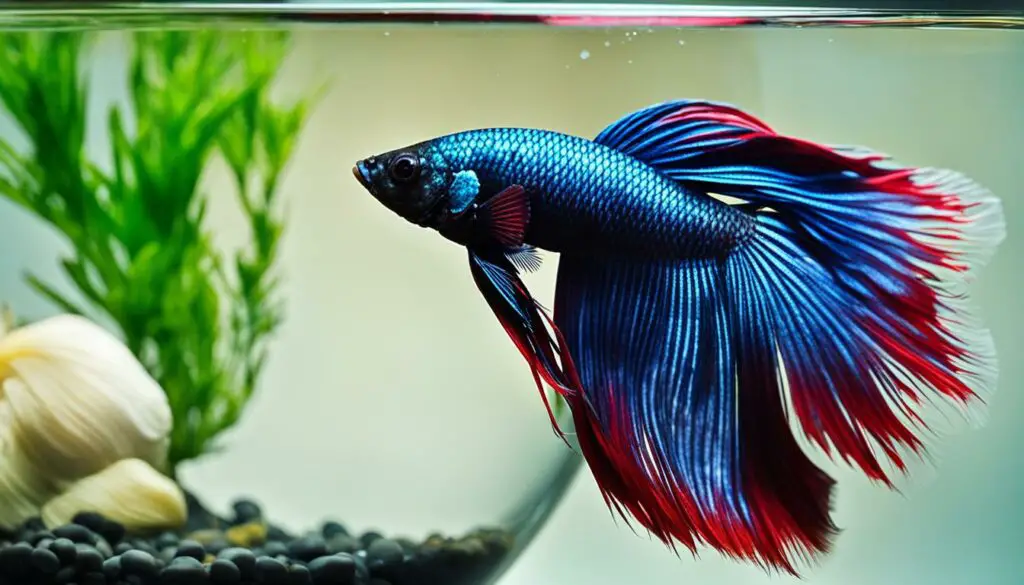
“Testing the water is a crucial step in ensuring the health and well-being of your betta fish. Regular testing and maintenance can prevent potential health issues and provide a safe and comfortable environment for your bettas.”
Maintaining Water Quality for Betta Fish
Ensuring the water quality in your betta fish’s habitat is vital for their health and overall well-being. Water quality parameters such as pH, temperature, ammonia, nitrite, and nitrate levels must be monitored regularly. These parameters can be affected by a variety of factors, including overfeeding, overcrowding, and lack of filtration.
One of the most important steps in maintaining water quality is performing regular water changes. A 25-50% water change should be done every week to remove waste and reduce the accumulation of harmful chemicals and bacteria. The frequency of water changes may vary depending on the size of the tank and the number of fish in the habitat.
It is also essential to clean the tank regularly. Cleaning the tank involves removing uneaten food, debris, and waste from the substrate and decorations. The substrate should be vacuumed, and the decorations should be scrubbed to remove any buildup of algae or bacteria.
Using a filter is another crucial aspect of maintaining water quality. Filters help to remove waste and debris from the water, promoting a healthy and clean environment for your betta fish. A filter should be chosen based on the size of the tank and the number of fish in the habitat.
While maintaining water quality, it is important to keep in mind that betta fish are sensitive to sudden changes in the water parameters. Therefore, any changes to the tank should be made gradually to avoid shocking the fish. For example, if the pH needs to be adjusted, it should be done slowly over several days or weeks.
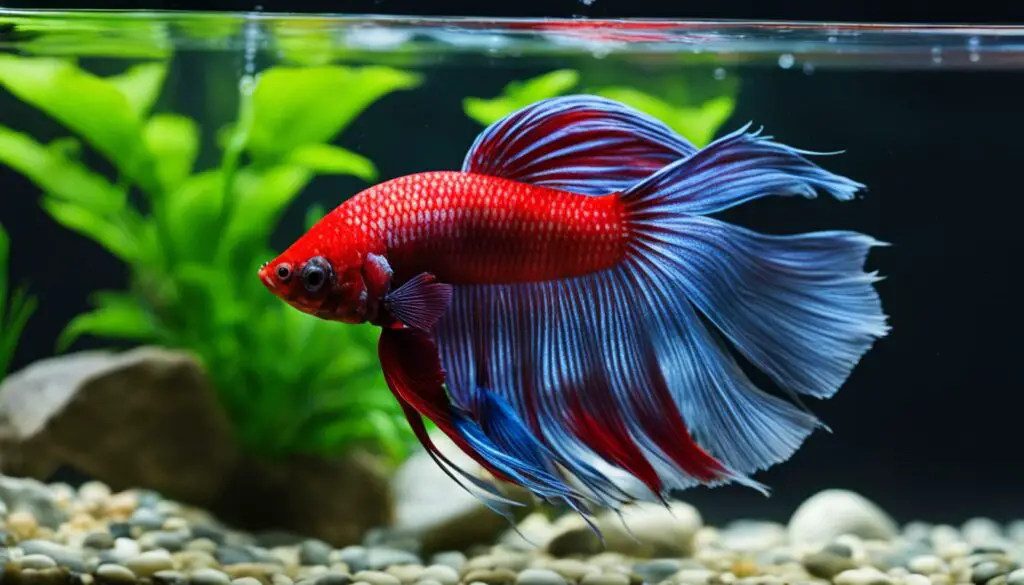
In conclusion, maintaining water quality is crucial for the health and well-being of betta fish. Performing regular water changes, cleaning the tank, using a filter, and making gradual changes to the water parameters are all essential steps in ensuring a safe and comfortable environment for your betta fish to thrive.
Common Mistakes to Avoid When Treating Tap Water for Betta Fish
When it comes to betta fish care, treating tap water is crucial for their overall health and well-being. However, there are several common mistakes that betta fish owners make when treating tap water. Here are some of the most common mistakes to avoid:
1. Not using the right amount of dechlorinator: Using too much or too little dechlorinator can be harmful to betta fish. Follow the instructions on the product carefully and measure the correct dose based on the amount of water you are treating.
2. Changing the water too frequently: While it may be tempting to change the water frequently to keep the tank clean, it can disrupt the balance of the aquarium and cause stress to your betta fish. Aim to change 20-25% of the water every week instead.
3. Neglecting to test the water: It’s vital to test the treated water regularly to ensure that it meets the necessary parameters for betta fish. Invest in a reliable water testing kit and check the pH, ammonia, nitrites, and nitrates levels.
4. Using untreated tap water: Tap water contains harmful chemicals such as chlorine and chloramines that can be toxic to betta fish. Always treat the tap water before adding it to your betta fish habitat.
5. Using untreated decorations: Decorations inside the aquarium, such as rocks and plants, may also contain harmful chemicals. Rinse them thoroughly and treat them before adding them to the aquarium.
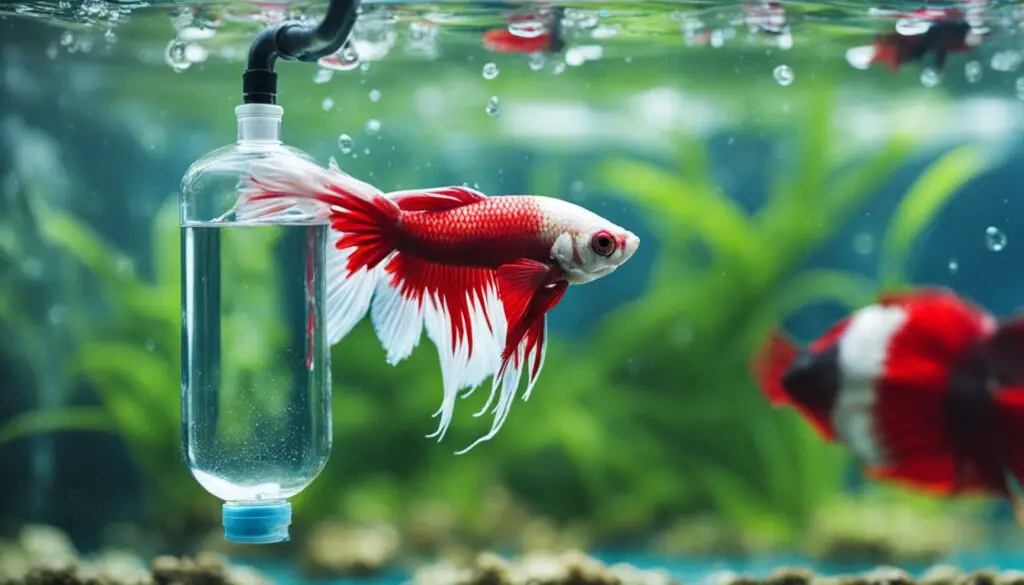
“By avoiding these common mistakes, you can provide a safe and healthy environment for your betta fish.”
It’s essential to understand that even small mistakes can have significant consequences when it comes to betta fish care. By avoiding these common mistakes, you can provide a safe and healthy environment for your betta fish. Always take the time to follow the instructions carefully and maintain a routine to keep your fish happy and healthy.
Alternative Solutions for Betta Fish Water Treatment
While treating tap water for betta fish without conditioner is an effective and affordable solution, there are alternative methods for betta fish water treatment. These include filtered water and bottled water, both of which can be found in most grocery stores.
Filtered water can be an excellent choice for betta fish care, as it removes impurities, chemicals, and minerals from tap water. While this method can be more expensive than treating tap water, it can be a viable alternative for those who want to ensure the highest level of water quality and safety for their bettas.
Bottled water is another option that can be used in a pinch. However, not all bottled water is created equal, and it is important to choose brands that do not contain additives, such as minerals or flavors, that can harm betta fish. Always check the label to ensure the water is free of any harmful substances before using it in the betta fish habitat.
While filtered and bottled water can be effective alternatives for betta fish water treatment, it is essential to consider the pros and cons compared to treating tap water without conditioner. Here is a comparison table to help you decide which option is right for you:
| Method | Pros | Cons |
|---|---|---|
| Tap Water Treatment Without Conditioner | Affordable, effective, and widely available | Requires careful preparation and monitoring |
| Filtered Water | Removes impurities, chemicals, and minerals from tap water | Can be more expensive, requires a filtration system |
| Bottled Water | Easily available and does not require any preparation | Can be expensive, not all brands are safe for betta fish |
When deciding which method to use, it is crucial to consider the needs of your betta fish and the resources available to you. Whichever method you choose, make sure to maintain proper water quality and regularly monitor the habitat to ensure the well-being of your bettas.
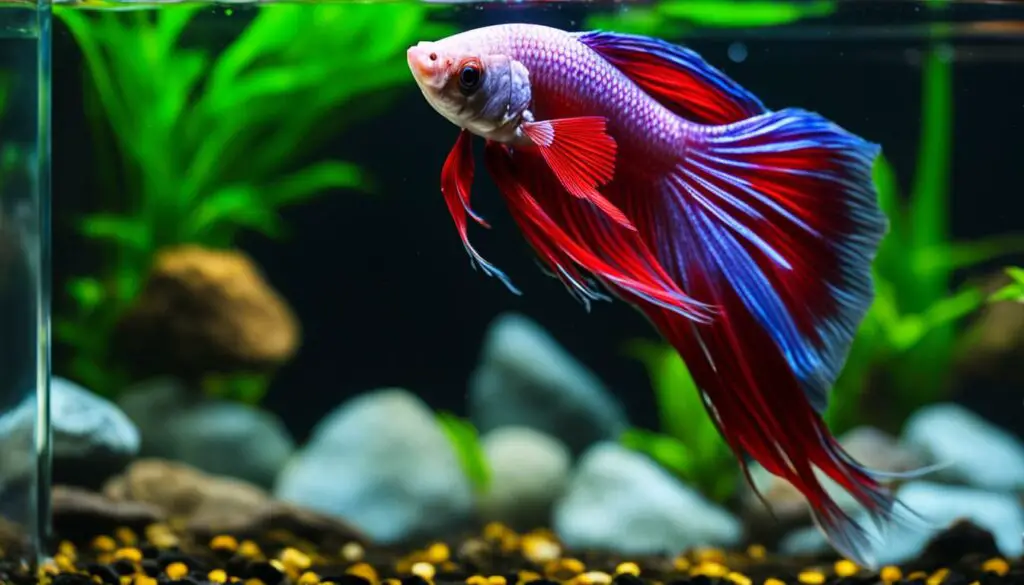
Conclusion
By following the steps outlined in this guide, you can provide safe and comfortable tap water for your betta fish without using traditional conditioners. Ensuring the water quality in their habitat is crucial for their health and well-being. Remember to test the water parameters regularly and maintain cleanliness in their environment.
Continue Providing the Best Care for Your Betta Fish
Now that you know how to treat tap water for betta fish without conditioner, you can continue providing the best care for your aquatic friends. Avoid common mistakes, such as skipping important steps, and consider alternative solutions, such as bottled or filtered water, if needed. Your betta fish will thrive in a clean and comfortable environment thanks to your dedication to their care.
Thank you for reading this guide on how to treat tap water for betta fish without conditioner. We hope you found it informative and valuable for your betta fish care routine.
FAQ
Why is it important to treat tap water for betta fish?
Tap water contains chemicals, such as chlorine and chloramine, that can be harmful to betta fish. Treating the water removes these chemicals and ensures a safer environment for your bettas.
Can I treat tap water for betta fish without using conditioner?
Yes, there are natural methods available to treat tap water without using traditional water conditioners. These alternatives are safe and effective for betta fish.
How do I treat tap water for betta fish naturally?
Natural methods to treat tap water for betta fish include using dechlorinator plants like Indian almond leaves, using activated carbon, or allowing the water to sit and aerate for 24 hours before adding it to the tank.
What is the step-by-step process for treating tap water for betta fish without conditioner?
The step-by-step process involves letting the tap water sit for 24 hours to allow the chlorine to dissipate, using natural treatment methods like activated carbon or Indian almond leaves, and testing the treated water to ensure it is suitable for betta fish.
How can I test the treated water for betta fish?
To test the treated water, you can use water testing kits specifically designed for aquariums. These kits will measure parameters such as pH, ammonia, nitrite, and nitrate levels to ensure the water quality is appropriate for betta fish.
How often should I test the water quality for betta fish?
It is recommended to test the water quality at least once a week or whenever you notice any changes in the behavior or health of your betta fish. Regular testing will help you maintain optimal water conditions.
What are some common mistakes to avoid when treating tap water for betta fish?
Common mistakes include using the wrong water treatment methods, neglecting to let the water sit for 24 hours to remove chlorine, and not testing the water after treatment. It’s important to follow the correct steps to ensure your betta fish’s well-being.
Can I use filtered or bottled water as an alternative to treating tap water?
Filtered or bottled water can be used as an alternative to treating tap water, but it is important to check the parameters of the water to ensure it is suitable for betta fish. Some filtered or bottled waters may still need additional treatment.

